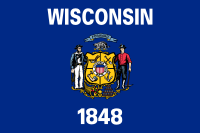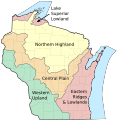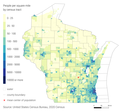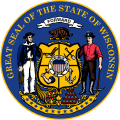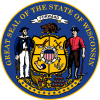Dairy is a major industry in the State of Wisconsin. Pictured is a worker in 1922 at a New Glarus cheese factory placing a Wisconsin stamp on wheels of cheese. The Flag of Wisconsin Wisconsin wisk-ON -sin state in the Great Lakes region of the Upper Midwest of the United States . It borders Minnesota to the west, Iowa to the southwest, Illinois to the south, Lake Michigan to the east, Michigan to the northeast, and Lake Superior to the north. Wisconsin is the 25th-largest state by land area and the 20th-most populous . It is divided into 72 counties and as of the 2020 census had a population of nearly 5.9 million. Its most populous city is Milwaukee , while its capital and second-most populous city is Madison . Other large population centers include Green Bay , Kenosha , Racine , and the Fox Cities .
Wisconsin's geography is diverse, shaped by Ice Age glaciers except for the Driftless Area . The Northern Highland and Western Upland along with a part of the Central Plain occupy the western part of the state, with lowlands stretching to the shore of Lake Michigan. Wisconsin is third to Ontario and Michigan in the length of its Great Lakes coastline. The northern portion of the state is home to the Chequamegon-Nicolet National Forest . At the time of European contact, the area was inhabited by Algonquian and Siouan nations, and today it is home to eleven federally recognized tribes . During the 19th and early 20th centuries, many European settlers entered the state, most of whom emigrated from Germany and Scandinavia . Wisconsin remains a center of German American and Scandinavian American culture, particularly in respect to its cuisine , with foods such as bratwurst and kringle .
Wisconsin is one of the nation's leading dairy producers and is known as "America's Dairyland"; it is particularly famous for its cheese . The state is also famous for its beer , particularly and historically in Milwaukee , most notably as the headquarters of the Miller Brewing Company . Wisconsin has some of the most permissive alcohol laws in the country and is known for its drinking culture . Its economy is dominated by manufacturing, healthcare, information technology, and agriculture—specifically dairy, cranberries , and ginseng . Tourism is also a major contributor to the state's economy. The gross domestic product in 2020 was $348 billion. Wisconsin is home to one UNESCO World Heritage Site , comprising two of the most significant buildings designed by Wisconsin-born architect Frank Lloyd Wright : his studio at Taliesin near Spring Green and his Jacobs I House in Madison. The Republican Party was founded in Wisconsin in 1854. In more recent years, Wisconsin has been a battleground state in presidential elections , notably in 2016 and 2020 . (Full article...
Entries here consist of Good and Featured articles, which meet a core set of high editorial standards. Russell W. Bogda (October 15, 1911 – February 22, 1958) was an American automotive executive and president of the
Green Bay Packers . From 1953 to 1957, he served as the sixth
president of the Green Bay Packers . During his presidency, the Packers secured funding and built New City Stadium, which would be renamed in 1965 to
Lambeau Field . Although the Packers during Bogda's tenure saw little on-field success, he helped the organization stay financially successful and the construction of a new stadium during his tenure kept the Packers in
Green Bay, Wisconsin . Bogda died at the age of 46 on February 22, 1958, of lung cancer. (
Full article... )
List of recognized articles
Wisconsin and the Wisconsin River
The Wisconsin River tributary of the Mississippi River in the U.S. state of Wisconsin . At approximately 430 miles (692 km) long, it is the state's longest river. The river's name was first recorded in 1673 by Jacques Marquette as "Meskousing" from his Indian guides - most likely Miami for "river running through a red place."
Before roads into Wisconsin, the river was canoed, hunted and fished by Indians. Loggers used the upper reaches of the river and its tributaries to drive logs to their sawmills and the lower reaches to float rafts of sawn boards to markets as near as
Portage and as far as
St. Louis . Today dams along the river generate hydroelectric power and people fish, boat, water-ski and sight-see on the river. (
Full article... )
List of selected articles
The following are images from various Wisconsin-related articles on Wikipedia.
Image 2 The
Francois Vertefeuille House in
Prairie du Chien was built in the 1810s by fur traders. (from
Wisconsin )
Image 3 Chief Black Hawk, by
George Catlin (from
History of Wisconsin )
Image 4 The
Daniel E. Krause Stone Barn in
Chase was built in 1903, as dairy farming spread across the state. (from
Wisconsin )
Image 5 Sun City Carnival Tour at
Summerfest , 2009 (from
Wisconsin )
Image 6 On May 29, 1948, the U.S. Post Office issued a
commemorative stamp celebrating the 100th anniversary of Wisconsin statehood, featuring the state capitol building and map of Wisconsin. (from
Wisconsin )
Image 7 The
Wisconsin State Capitol is located on the
isthmus between
Lake Mendota and
Lake Monona , in the city of
Madison . (from
Wisconsin )
Image 8 A stone barn built for cows in Wisconsin. The circular
silo was used to store feed. (from
History of Wisconsin )
Image 10 Wisconsin in 1718,
Guillaume de L'Isle map, with the approximate state area highlighted (from
Wisconsin )
Image 12 Jean Nicolet , depicted in a 1910 painting by Frank Rohrbeck, was probably the first European to explore Wisconsin. The mural is located in the
Brown County Courthouse in Green Bay. (from
Wisconsin )
Image 13 Wisconsin counties (from
Geography of Wisconsin )
Image 14 Map of Wisconsin Territory 1836–1848 (from
History of Wisconsin )
Image 15 The
Driftless Area of southwestern Wisconsin is characterized by bluffs carved in
sedimentary rock by water from melting
Ice age glaciers. (from
Wisconsin )
Image 16 The
Driftless Area of southwestern Wisconsin is characterized by bluffs carved in
sedimentary rock by water from melting
Ice Age glaciers. (from
Geography of Wisconsin )
Image 18 Timms Hill is the highest natural point in Wisconsin at 1,951.5 ft (594.8 m); it is located in the town of
Hill ,
Price County . (from
Geography of Wisconsin )
Image 19 The color guard of the Wisconsin 8th Infantry with Old Abe (from
History of Wisconsin )
Image 20 Köppen climate types of Wisconsin (from
Wisconsin )
Image 21 Wisconsin Governor
Robert M. La Follette addresses an assembly, 1905 (from
Wisconsin )
Image 22 Köppen climate types of Wisconsin (from
Wisconsin )
Image 23 Fried
cheese curds (from
Wisconsin )
Image 24 1865 map Wisconsin prepared by
Increase Lapham (from
History of Wisconsin )
Image 25 The
Senate Chamber of the Wisconsin State Capitol (from
Wisconsin )
Image 26 Sun City Carnival Tour at
Summerfest , 2009 (from
Wisconsin )
Image 27 The
Apostle Islands are a group of 22 islands in
Lake Superior in northern Wisconsin. (from
Wisconsin )
Image 28 Suffragists campaigning, 1916. Wisconsin was among the earliest states to ratify the
Nineteenth Amendment . (from
Wisconsin )
Image 29 The
2011 Wisconsin Act 10 led to large protests around the state capitol building in Madison. (from
Wisconsin )
Image 30 Wisconsin counties (from
Wisconsin )
Image 32 Location of Wisconsin in the United States (from
Geography of Wisconsin )
Image 33 Wisconsin Governor
Robert M. La Follette addresses an assembly, 1905 (from
Wisconsin )
Image 34 The
Francois Vertefeuille House in
Prairie du Chien was built in the 1810s by fur traders. (from
Wisconsin )
Image 35 Wisconsin welcome sign (from
Wisconsin )
Image 36 Wisconsin is divided into five geographic regions. (from
Geography of Wisconsin )
Image 37 Kringle is based off its
Danish counterpart and is the official state
pastry . (from
Wisconsin )
Image 38 The
Senate Chamber of the Wisconsin State Capitol (from
Wisconsin )
Image 39 Suffragists campaigning, 1916. Wisconsin was among the earliest states to ratify the
Nineteenth Amendment . (from
Wisconsin )
Image 41 Fried
cheese curds (from
Wisconsin )
Image 42 The
Little White Schoolhouse in
Ripon held the nation's first meeting of the
Republican Party . (from
Wisconsin )
Image 43 The
Apostle Islands are a group of 22 islands in
Lake Superior in northern Wisconsin. (from
Wisconsin )
Image 45 Map of counties in Wisconsin by racial plurality, per the 2020 U.S. census
Non-Hispanic White 40–50%
60–70%
70–80%
80–90%
90%+
Native American 80–90%
(from
Wisconsin )
Image 46 The
American badger is the
state animal of Wisconsin. (from
Wisconsin )
Image 47 Jean Nicolet 's 1634 landing in Wisconsin (from
History of Wisconsin )
Image 48 The
Little White Schoolhouse , in Ripon, 1854, which hosted the first meeting of what became the national Republican Party (from
History of Wisconsin )
Image 50 Ethnic origins in Wisconsin (from
Wisconsin )
Image 51 Dairy cows at a
Wisconsin dairy farm (from
Wisconsin )
Image 52 Wisconsin is divided into five geographic regions. (from
Wisconsin )
Image 54 Wisconsin in 1718,
Guillaume de L'Isle map, approximate state area highlighted (from
History of Wisconsin )
Image 55 A general map of Wisconsin (from
Geography of Wisconsin )
Image 56 The largest platform mound at
Aztalan , with modern reconstructions of steps and stockade (from
History of Wisconsin )
Image 58 Wisconsin in 1718,
Guillaume de L'Isle map, with the approximate state area highlighted (from
Wisconsin )
Image 59 The
Wisconsin State Capitol is located on the
isthmus between
Lake Mendota and
Lake Monona , in the city of
Madison . (from
Wisconsin )
Image 60 Wisconsin 2020 Population Density Map (from
Wisconsin )
Image 64 Wisconsin Governor
Robert La Follette in 1905 (from
History of Wisconsin )
Image 65 The
state seal of Wisconsin contains a shovel and pickaxe, reflecting the importance of lead mining to Wisconsin's history. (from
History of Wisconsin )
Image 66 On May 29, 1948, the U.S. Post Office issued a
commemorative stamp celebrating the 100th anniversary of Wisconsin statehood, featuring the state capitol building and map of Wisconsin. (from
Wisconsin )
Image 67 The
Driftless Area of southwestern Wisconsin is characterized by bluffs carved in
sedimentary rock by water from melting
Ice age glaciers. (from
Wisconsin )
Image 68 The
2011 Wisconsin Act 10 led to large protests around the state capitol building in Madison. (from
Wisconsin )
Image 69 The
Little White Schoolhouse in
Ripon held the nation's first meeting of the
Republican Party . (from
Wisconsin )
Image 70 Wisconsin welcome sign (from
Wisconsin )
Image 72 Wisconsin congressman
Paul Ryan was the 2012 Republican Party nominee for vice president, and later served as the
speaker of the House of Representatives from 2015 to 2019.
Image 73 The
Pabst Building was the first skyscraper in
Milwaukee , Completed in 1891, Demolished in 1981. (from
History of Wisconsin )
Image 74 Map of counties in Wisconsin by racial plurality, per the 2020 U.S. census
Non-Hispanic White 40–50%
60–70%
70–80%
80–90%
90%+
Native American 80–90%
(from
Wisconsin )
Image 75 Wisconsin is divided into five geographic regions. (from
Wisconsin )
Image 76 The
American badger is the
state animal of Wisconsin. (from
Wisconsin )
Image 78 Logs being transported on a sleigh after being cut (from
History of Wisconsin )
Image 79 Kringle is based off its
Danish counterpart and is the official state
pastry . (from
Wisconsin )
Image 80 Wisconsin counties (from
Wisconsin )
Image 81 Jean Nicolet , depicted in a 1910 painting by Frank Rohrbeck, was probably the first European to explore Wisconsin. The mural is located in the
Brown County Courthouse in Green Bay. (from
Wisconsin )
Image 82 Wisconsin congressman
Paul Ryan was the 2012 Republican Party nominee for vice president, and later served as the
speaker of the House of Representatives from 2015 to 2019.
Image 86 Dairy cows at a
Wisconsin dairy farm (from
Wisconsin )
Image 87 The
Daniel E. Krause Stone Barn in
Chase was built in 1903, as dairy farming spread across the state. (from
Wisconsin )
Image 88 Drawing of a mastodon skeleton by
Rembrandt Peale (from
History of Wisconsin )
Image 90 Ethnic origins in Wisconsin (from
Wisconsin )
Image 92 Wisconsin 2020 Population Density Map (from
Wisconsin )
Largest cities or towns in Wisconsin
Rank
Name
County
Pop.
Milwaukee Madison
1
Milwaukee Milwaukee 577,222
Green Bay Kenosha
2
Madison Dane 269,840
3
Green Bay Brown 107,395
4
Kenosha Kenosha 99,986
5
Racine Racine 77,816
6
Appleton Outagamie 75,644
7
Waukesha Waukesha 71,158
8
Eau Claire Eau Claire 69,421
9
Oshkosh Winnebago 66,816
10
Janesville Rock 65,615
Category puzzle Select [►] to view subcategories
Here are some tasks awaiting attention:
